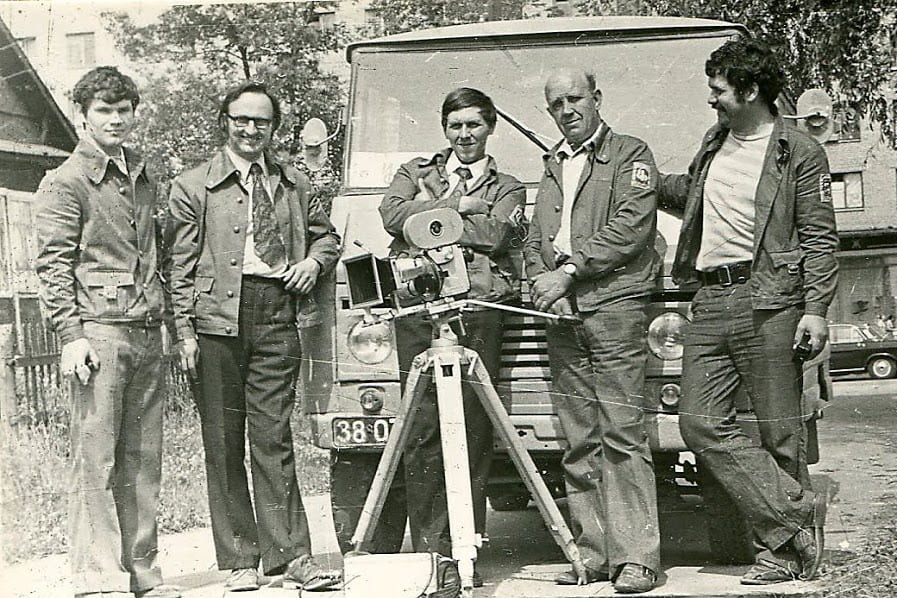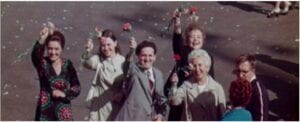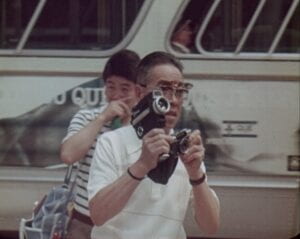For complete screening notes, click here

Leningrad, ca.1987
KHRONIKA KINOSTUDII [Chronicles of Izhor-Film] (People’s Film Studio Izhor-Film, Leningrad, USSR, ca. 1987) 10.5 min., 16mm, b/w, silent 115 meters (live piano accompaniment by Stephen Horne).
A home movie of a kind, this film portrays life and times of its studio, using fragments and outtakes from its earlier films, demonstrating tricks and filming each other. Compiled collectively by Izhor-Film filmmakers.
Source: Museum of Izhora Factories (Muzei Izhorskikh zavodov), St. Petersburg
Note: People’s Film Studio Izhor-Film was one of the best-known amateur film collectives in Leningrad (now St. Petersburg). Housed at Izhora Factories, a major heavy industry plant, the studio made industrial and other “useful” films for its factory, as well as documentary, travel and fiction films “for fun”. The reel signed as Khronika kinostudii includes working moments from films shot between the late 1970s and mid-1980s, as well as demonstration of tricks with disappearing objects and filmmakers themselves posing for the camera.
ARCHÄO-LOGISCHES [Archaeo-logical Stuff] (GDR, 1966) 13 min. 16mm, sound, b&w, 154 meters (Screened in digital video)
Produced by EKO Eisenhüttenstadt; written and directed by Reimar Rockstroh; Cinematography by Karl Jacob.
Source: Arcelor/Mittal / Digitized at HFF “Konrad Wolf” (Potsdam-Babelsberg)
How public and especially green spaces are being vandalized in Eisenhüttenstadt.
Note: A satirical and experimental amateur documentary made at the corporate film studio of GDR’s largest steel mill, EKO Eisenhüttenstadt, which operated from 1958 to 1989.
MILCHIG-TRÜBE [Milky Fishy] (GDR, 1983) 2 min. 16mm, sound, color, 22 meters German with English subtitles. (Screened in digital video).
Produced by Amateur Film Studio, Potsdam
Directed by Eberhard Derlig
Source: Filmmuseum Potsdam
Children snatch at milk bags in leaking packages. The milk trust accept the reclamation and finds his own (absurd) way to deliver the missing milk.
DER FAVORIT [The Favorite] (GDR, 1982) 2.5 min. 16mm, sound, color, 27 meters (Screened in digital video)
Produced and directed by Angelika and Horst Butter, Studio 63, Berlin (East).
A star figure skater wins a competition – wrongly and with some injuries. Puppet animation.
Source: Filmmuseum Potsdam
Note: A longer version runs 8 minutes; recycled from the film Glatteis (part of the UNICA program of the GDR 1982).
DER MINISTER KOMMT [The Minister Comes] (GDR, 1984) 5.5 min, 16mm, sound, color, 33 meters (Screened in digital video).
Produced by AmateurFilmZirkel, AFZ Senftenberg; written and directed by Frank Dietrich.
Source: Frank Dietrich (Videofilmer Senftenberg) / Filmmuseum Potsdam
Application of computers in the industry: dusty robots are briefly put to work as the secretary of state is visiting the factory.
Note: Award from competition of amateur films of the DDR; Eulenspiegeleien, 1987.
X + Y (Czechoslovakia, 1963) 7 min 16mm, silent, b&w, 68 meters. Amateur film group-TIGR (Miroslav Koplík, Josef Groz, Dušan Tichý)
Source: National Film Archive, Czech Republic
Little girl playing with a ball on the boundary line of two opposing armies. Initial situation of animated film inspired by the atmosphere of the Cold War.
MAŠINÉRIE [Machinery] (Czechoslovakia, 1985) 10 min. 16mm, sound, col., 103 meters. Directed by Pavel Bárta, Zdeněk Lorenz
Source: National Film Archive, Czech Republic
Failure of the machine becomes a cause for realizing other options of existence.
Note: New 16mm print from .
NA OGNOI ZEMLE [On the Same Earth] (People’s Film Studio of DK Proftekhobrazovania, Leningrad, USSR, 1976) 10 min.
35mm, sound, color, 290 meters (Screened in digital video).
Written, directed, shot and edited by Dmitrii Medvedev
Script consultant: Boris Goller.
Soviet amateur dance ensemble boards a ship and travels to Canada at the time when traveling abroad was akin to flying to the moon.
Source: Dmitrii Medvedev, Moscow

Note: On the Same Earth is an example of a unique phenomenon in Soviet amateur filmmaking: films shot on the professional 35mm gauge. Although there were many critics of this practice within Soviet amateur film movement, it continued from the late 1920s when small-gauge film was not available in the USSR until the early 1990s when organised amateur filmmaking declined with the end of the Soviet Union and the end state support.
On the Same Earth was shot in July 1976, during the summer Olympics in Montreal. The ship Mikhail Kalinin was sent to support the Soviet team and carried a few dozen artists that gave performances in the Olympic village, as well as at venues of various sizes in Montreal and Toronto. Somewhat invisible among them was a “man with a movie camera” – Vladimir Medvedev, an amateur filmmaker from people’s film studio of the Palace of Culture of Professional Technical Schools of Leningrad (DK Proftekhobrazovania).
The running time of the first edition was 40 minutes. However, the director of the palace of culture found that the West appeared “too colorful” in this film. The authors prepared another edition, only 10 minutes long – and this is the version that we know today. It was screened publicly only once and remained shelved since then. A high definition digital transfer of this film was prepared for Orphan Film Symposium in January 2014.
For more about On the Same Earth, read Maria Vinogradova’s notes here.
